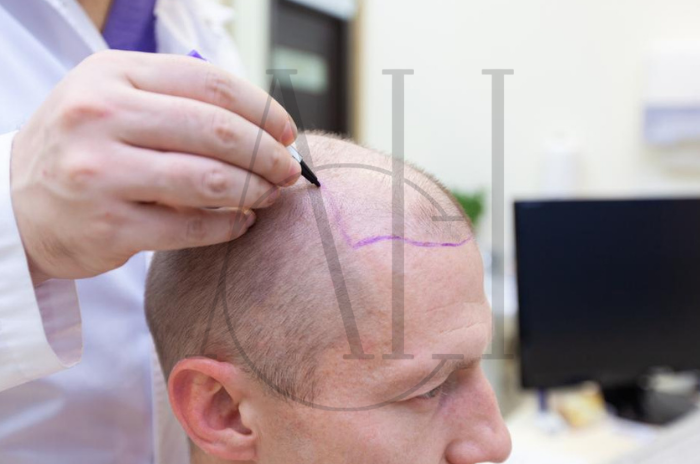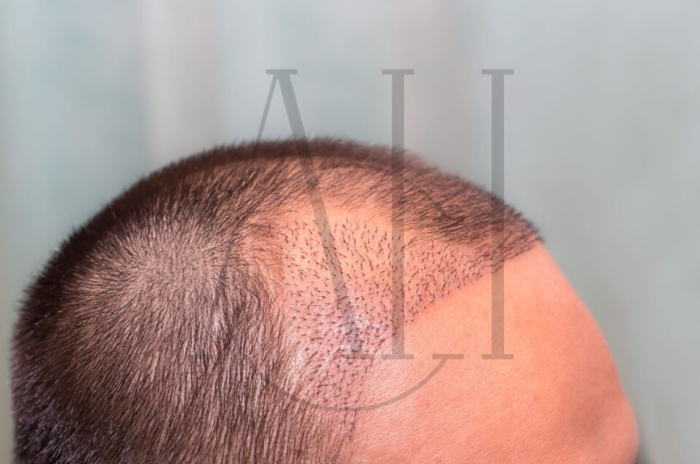Deciding when to return to work after a hair transplant is one of the most common concerns patients have following their procedure. The timing depends on multiple factors including the type of transplant performed, your occupation, healing progress, and personal comfort level with visible recovery signs. This comprehensive guide will help you understand the key factors that influence your return-to-work timeline and provide practical strategies for a smooth transition back to your professional life.
Understanding your recovery timeline is crucial for planning time off work and ensuring optimal healing results. While some patients can return to desk jobs within 2-3 days, others may need up to two weeks depending on their specific circumstances. The key is balancing professional responsibilities with proper healing to protect your investment in hair restoration.
Table of Contents
ToggleWhat Influences Return-to-Work Timing
Several critical factors determine how quickly you can safely return to work after your hair transplant procedure. Understanding these variables helps set realistic expectations and plan accordingly.
Nature of Your Job
Your occupation plays the most significant role in determining your return-to-work timeline. Different job types present varying levels of risk to your healing grafts and overall recovery process.
Desk Jobs and Office Work: Office-based professionals typically have the most flexible return options. These positions involve minimal physical strain and allow for easier management of post-operative care. Key considerations include:
- Limited physical exertion reduces sweat production
- Air-conditioned environments minimize infection risk
- Flexible dress codes often accommodate hats or head coverings
- Ability to take breaks for medication and scalp care
- Lower risk of accidental trauma to transplanted area
Physical Labor and Manual Work: Jobs requiring heavy lifting, outdoor work, or significant physical activity present greater challenges:
- Increased sweating can affect graft healing
- Risk of accidental bumps or impacts to the head
- Exposure to dust, dirt, and environmental contaminants
- Difficulty maintaining proper scalp hygiene
- Higher infection risk due to working conditions
Customer-Facing Roles: Positions involving frequent client interaction require special consideration for appearance management:
- Need for professional appearance during visible healing phase
- Potential discomfort with client questions about appearance
- Limited options for wearing hats or head coverings
- Importance of timing procedure around light work periods
Transplant Technique (FUE vs FUT)
The surgical technique used significantly impacts your recovery timeline and return-to-work considerations.
FUE (Follicular Unit Extraction) Recovery: FUE procedures typically offer faster recovery times due to their minimally invasive nature:
- No linear incision means less overall trauma
- Reduced pain and discomfort
- Faster healing of tiny extraction sites
- Earlier return to most activities
- Less visible scarring in donor area
FUT (Follicular Unit Transplantation) Recovery: FUT procedures require additional healing time due to the strip harvest method:
- Linear incision requires suture removal at 10-14 days
- More post-operative discomfort initially
- Longer restriction on lifting and bending
- Need to protect donor area from stretching
- Visible linear scar requires longer hair to conceal
General Return-to-Work Timelines
Understanding typical recovery timelines helps you plan your time off and set appropriate expectations with your employer.
FUE: Working from Home vs Office vs Manual Labor
FUE procedures offer more flexibility in return-to-work timing due to their less invasive nature:
Working from Home (1-3 Days): Remote work provides the ideal recovery environment for FUE patients:
- Can begin light computer work within 24-48 hours
- Comfortable environment for managing swelling and discomfort
- Easy access to prescribed medications and scalp care
- Ability to take frequent breaks as needed
- No concerns about appearance during video calls (camera off option)
Office Work (3-7 Days): Returning to an office environment requires additional considerations:
- Most patients comfortable returning by day 3-5
- Minimal swelling and redness by this timeframe
- Ability to wear hat or head covering if needed
- Should avoid strenuous activities or heavy lifting
- May need to explain temporary appearance changes to colleagues
Manual Labor (7-14 Days): Physical jobs require the longest recovery period:
- Minimum 7-10 days for basic physical activity
- Full return typically by day 10-14
- Must ensure all scabs have naturally fallen off
- Sweat and environmental exposure considerations
- May need modified duties initially
FUT: Extra Recovery Time Required
FUT procedures necessitate longer recovery periods across all job types:
Extended Healing Timeline: The strip harvest method creates additional recovery requirements:
- Suture line requires 10-14 days to heal properly
- Risk of suture line separation with early activity
- More significant initial discomfort and swelling
- Longer medication schedule for pain management
- Need for careful sleeping position during initial week
Return-to-Work Schedule:
- Desk work: 5-7 days minimum
- Office work: 7-10 days
- Manual labor: 14-21 days
- Heavy lifting: 3-4 weeks
Safety Margins: Avoiding Early Return to Prevent Graft Displacement
Returning to work too early can jeopardize your transplant results and overall investment. Critical safety considerations include:
Graft Security Timeline:
- Days 1-3: Grafts extremely vulnerable to displacement
- Days 4-7: Grafts beginning to establish blood supply
- Days 8-10: Grafts becoming more secure but still fragile
- Days 10-14: Grafts well-established and resistant to normal activity
Risk Factors for Early Return:
- Accidental trauma to transplanted area
- Excessive sweating affecting graft healing
- Infection from environmental exposure
- Increased swelling from activity
- Disruption of post-operative care routine
Healing Milestones by Day
Understanding the day-by-day healing process helps you recognize when it’s safe to resume various activities and return to work.
| Day Range | Healing Milestones | Work Considerations |
|---|---|---|
| Days 1-2 | Peak swelling, initial discomfort | Complete rest recommended |
| Days 3-5 | Swelling reduces, scabs form | Light desk work possible |
| Days 7-10 | Redness subsides, scabs loosen | Most office work comfortable |
| Days 10-14 | Scabs fall off, grafts secure | Full activity clearance |

Days 1–2: Rest, Swelling, and Washing Restrictions
The first 48 hours represent the most critical period for graft survival and overall healing success.
Physical Changes: During this initial period, patients typically experience:
- Maximum swelling, particularly around the forehead and eyes
- Mild to moderate discomfort managed with prescribed medications
- Protective scab formation around newly transplanted grafts
- Some bleeding spotting from recipient sites (normal)
- Tightness sensation in donor area (especially with FUT)
Activity Restrictions:
- Complete bed rest for first 24 hours
- No washing or touching of transplanted area
- Sleep with head elevated at 45-degree angle
- Avoid bending, lifting, or strenuous activity
- No work of any kind recommended
Care Requirements:
- Take prescribed medications on schedule
- Apply ice packs to forehead (not directly on grafts)
- Gentle saline spray to keep grafts moist
- Avoid alcohol and smoking completely
- Stay hydrated and eat nutritious meals
Days 3–5: Desk Work Resumes, Scabs Start Falling Off
This period marks the beginning of recovery when light work activities can typically resume.
Physical Improvements:
- Significant reduction in swelling
- Decreased discomfort and pain
- First gentle washing allowed (usually day 3)
- Scabs begin to loosen naturally
- Energy levels starting to return
Work Readiness:
- Light computer work from home possible
- Short periods of concentration manageable
- May still need frequent breaks for comfort
- Appearance concerns may limit office return
- Phone/video meetings possible with camera off
Ongoing Precautions:
- Gentle washing technique only
- No scratching or picking at scabs
- Continue sleeping with head elevated
- Avoid direct sunlight exposure
- Maintain medication schedule
Days 7–10: Redness Subsides, Minimal Visible Signs
Week two brings significant cosmetic improvement and increased comfort with public appearance.
Healing Progress:
- Most swelling resolved
- Redness fading to pink
- Majority of scabs naturally shed
- Grafts becoming more secure
- Donor area healing well (FUE) or sutures ready for removal (FUT)
Professional Readiness:
- Comfortable returning to office environment
- Able to participate in meetings and presentations
- Professional appearance acceptable with or without hat
- Full concentration and productivity possible
- Can explain procedure confidently if asked
Days 10–14: Secure Grafts, End of Visible Scabs, Ready for Physical/Outdoor Jobs
The two-week mark represents full clearance for most work activities and environments.
Complete Healing Indicators:
- All scabs naturally fallen off
- Minimal redness remaining
- Grafts firmly established
- Full range of motion comfortable
- Normal sleep patterns resumed
Full Work Clearance:
- All job types typically cleared
- Physical labor and outdoor work safe
- Normal lifting and bending permitted
- Sweating no longer contraindicated
- Full professional presentation possible
Managing Visible Effects at Work
Successfully managing the cosmetic aspects of recovery can make your return to work more comfortable and professional.
Redness & Swelling: Camouflage Tips (Hats, Scarves)
Strategic use of accessories can effectively conceal healing signs while maintaining professional appearance.
Hat Selection and Usage: Choose appropriate headwear based on your work environment:
- Baseball caps: Casual offices, outdoor work
- Fedoras or dress hats: Professional business environments
- Beanies: Casual, creative workplaces
- Head scarves: Versatile option for various settings
Styling Considerations:
- Ensure hat fits loosely to avoid pressure on grafts
- Choose colors that complement your professional wardrobe
- Have multiple options for different occasions
- Practice wearing style before returning to work
Alternative Camouflage Methods:
- Strategic hairstyling to cover recipient area
- Makeup to minimize redness (after day 10)
- Clothing choices that draw attention away from head
- Confident body language to minimize self-consciousness
Scabbing: How Long and When It Clears
Understanding the scabbing process helps set realistic expectations for appearance improvement.
Scab Timeline:
- Formation: Days 1-3, protective crusts develop
- Maturation: Days 4-7, scabs darken and harden
- Loosening: Days 7-10, natural shedding begins
- Complete clearance: Days 10-14, all scabs gone
Professional Management:
- Never pick or scratch scabs artificially
- Use gentle washing to encourage natural shedding
- Apply recommended moisturizers to prevent excessive dryness
- Understand that some patients clear faster than others
- Plan return timing around your individual healing rate
Risks of Returning Too Soon
Premature return to work can compromise your transplant results and create additional complications.
Graft Displacement & “Shock Loss”
The most serious risk of early return involves damage to newly transplanted grafts.
Graft Displacement Mechanisms:
- Direct trauma from bumps or impacts
- Friction from hats, headsets, or equipment
- Excessive sweating loosening graft adhesion
- Scratching or rubbing transplanted area
- Pressure from sleeping in awkward positions at work
Shock Loss Complications: Premature activity can trigger shock loss, where existing hair around the transplant area temporarily falls out:
- Stress-induced telogen effluvium
- Disrupted blood supply to existing follicles
- Inflammatory response from early activity
- Can affect both transplanted and native hair
- Usually temporary but delays overall results

Sweat, Pressure, & Infection Risks
Work environments can introduce multiple healing complications if resumed too early.
Sweating Complications:
- Salt in sweat can irritate healing grafts
- Moisture creates bacterial growth environment
- Difficulty maintaining proper scalp hygiene
- May delay scab formation and natural shedding
- Increased risk of folliculitis development
Pressure and Contact Issues:
- Wearing headsets, helmets, or safety equipment
- Leaning head against surfaces during work
- Carrying heavy items that require head/neck strain
- Sleeping awkwardly during work breaks
- Accidental contact during normal work activities
Infection Prevention: Working environments often expose healing scalps to:
- Airborne dust and contaminants
- Bacteria from shared equipment
- Chemical exposure in certain industries
- Inadequate facilities for proper scalp care
- Limited access to prescribed medications
Tips to Smooth Return to Work
Strategic planning can make your transition back to work more comfortable and successful.
Best Timing: Leveraging Weekends Strategically
Optimal procedure scheduling can minimize work disruption and maximize healing time.
Friday Procedure Advantages: Scheduling your transplant on a Friday provides:
- Weekend for initial critical healing
- Monday return possible for desk jobs
- Reduced questions from colleagues about absence
- Natural explanation for any appearance changes
- Access to weekend rest and recovery time
Extended Weekend Planning: Consider scheduling around holidays or long weekends:
- Memorial Day, Labor Day, or other three-day weekends
- Vacation time combined with natural breaks
- Holiday periods when offices are quieter
- Summer schedules that may be more flexible
Modified Work Plans & Communication with Employer
Transparent communication with your employer can facilitate a smoother return process.
Advance Planning Discussions:
- Inform supervisor of planned medical procedure
- Discuss potential work-from-home options
- Arrange for backup coverage of essential duties
- Set realistic expectations for initial productivity
- Obtain written approval for modified schedules
Return-to-Work Accommodations:
- Flexible hours for medical appointments
- Work-from-home options during initial healing
- Modified duties avoiding physical strain
- Private workspace to manage appearance concerns
- Understanding of potential need for additional time off
Scalp Care at Work: Hygiene, Medications, Hats
Maintaining proper post-operative care while at work requires advance planning and organization.
Workplace Care Kit:
- Gentle cleansing products for midday touch-ups
- Prescribed medications with proper timing
- Clean hats or head coverings
- Moisturizing sprays for scalp comfort
- Hand sanitizer for hygiene before touching scalp
Discrete Care Strategies:
- Schedule medication times around work breaks
- Use private bathrooms for scalp care when needed
- Keep care products in desk drawer or locker
- Plan outfit changes if needed for comfort
- Have backup supplies at workplace
Can You Work Remotely or Need Time Off?
Different work arrangements offer varying advantages during the hair transplant recovery period.
Desk Jobs vs. Physically Demanding Jobs
The type of work you perform significantly impacts your recovery timeline and requirements.
Desk Job Advantages: Remote and office-based work offers optimal recovery conditions:
- Controlled environment: Climate control reduces infection risk
- Flexible positioning: Can adjust chair and monitor height for comfort
- Minimal physical strain: Reduces sweat production and trauma risk
- Easy medication access: Can maintain prescribed care routine
- Professional appearance control: Can manage visibility of healing process
Physical Job Challenges: Manual labor and outdoor work present additional recovery hurdles:
- Environmental exposure: Dust, dirt, and weather affect healing
- Safety equipment conflicts: Hard hats, helmets may not fit properly
- Increased trauma risk: Higher likelihood of accidental impacts
- Hygiene limitations: Limited access to proper scalp care facilities
- Sweat production: Heavy perspiration can affect graft healing
Tips for Hiding Signs of Surgery (Hats, Hairstyles)
Strategic appearance management can boost confidence during your return to work.
Professional Hat Options:
| Work Environment | Recommended Headwear | Key Considerations |
|---|---|---|
| Corporate Office | Fedora, Dress Hat | Must match professional attire |
| Casual Office | Baseball Cap, Beanie | Company dress code permitting |
| Outdoor Work | Wide-brim Hat | Sun protection + healing coverage |
| Creative Fields | Artistic Caps, Bandanas | Express personal style |
Hairstyling Strategies:
- Strategic combing: Direct existing hair over recipient areas
- Temporary hair fibers: Cosmetic products to add density appearance
- Professional styling: Consider salon visit for optimal coverage
- Length adjustments: May need slight trim for even appearance
- Product selection: Use gentle, non-irritating styling products
Confidence Building Techniques:
- Practice explaining procedure positively if asked
- Focus on long-term benefits rather than temporary appearance
- Maintain normal professional demeanor and productivity
- Remember that most people notice appearance changes less than you think
- Consider procedure as investment in future confidence and career
Post-Transplant Care for Faster Healing
Proper post-operative care accelerates healing and improves your ability to return to work quickly.
Dos and Don’ts in the First 2 Weeks
Following specific guidelines during the critical first two weeks ensures optimal healing and fastest safe return to work.
Essential Dos:
- Sleep elevated: Keep head raised 45 degrees for first week
- Gentle washing: Follow prescribed washing technique starting day 3
- Medication compliance: Take all prescribed medications on schedule
- Hydration: Drink plenty of water to support healing
- Nutritious diet: Eat protein-rich foods to support hair growth
- Sun protection: Avoid direct UV exposure for 2 weeks
- Regular follow-ups: Attend all scheduled post-op appointments
Critical Don’ts:
- No touching: Avoid touching, scratching, or picking at grafts
- No smoking: Nicotine severely impairs healing and graft survival
- No alcohol: Can interfere with medications and healing
- No swimming: Avoid pools, hot tubs, and ocean water
- No heavy lifting: Avoid straining that increases blood pressure
- No direct heat: Stay away from hair dryers, saunas, steam rooms
- No vigorous exercise: Postpone gym workouts and sports
When Can You Exercise or Sweat Heavily?
Physical activity restrictions vary based on the intensity and type of exercise.
Exercise Timeline:
- Days 1-7: Complete rest, no exercise
- Days 8-14: Light walking only
- Days 15-21: Moderate cardio, no weights
- Days 22-30: Full gym return with precautions
- Month 2+: Normal exercise routine
Gradual Return Strategy:
- Week 1: Focus on rest and healing
- Week 2: Short, gentle walks
- Week 3: Light cardio machines (treadmill, stationary bike)
- Week 4: Add light weights, avoid overhead exercises
- Month 2: Resume normal workout intensity
Sweating Considerations: Heavy perspiration can affect healing, so gradual return is essential:
- Start with activities that produce minimal sweat
- Shower immediately after any exercise
- Use gentle, prescribed shampoos only
- Pat scalp dry gently, never rub vigorously
- Monitor for any signs of irritation or infection
Signs of Complications (When to Call Your Doctor)
Recognizing potential complications early ensures prompt treatment and protects your transplant investment.
Immediate Emergency Signs: Contact your surgical team immediately if you experience:
- Excessive bleeding: More than light spotting after day 2
- Severe swelling: Swelling that worsens after day 3
- Signs of infection: Increased redness, warmth, pus, or fever
- Severe pain: Pain not controlled by prescribed medications
- Graft displacement: Visible movement or loss of transplanted grafts
Concerning but Non-Emergency Signs: Schedule prompt follow-up for:
- Persistent headaches beyond first week
- Unusual itching or burning sensations
- Delayed scab formation or excessive scabbing
- Asymmetric healing between sides
- Unexpected hair shedding in donor area
Normal vs. Abnormal Healing: Understanding normal healing helps identify when to seek help:
| Normal Healing | Concerning Signs |
|---|---|
| Gradual swelling reduction | Increasing swelling after day 3 |
| Light spotting first 48 hours | Heavy bleeding beyond day 2 |
| Mild discomfort controlled by medication | Severe pain unrelieved by prescribed drugs |
| Scabs forming and falling off naturally | Persistent scabs beyond 2 weeks |
| Slight redness fading daily | Increasing redness or heat |
Working with an intermediary organization can help ensure you have proper access to post-operative care and can address concerns promptly.
FAQ
How soon after a hair transplant can I return to work?
The timeline depends on your job type and transplant method. For desk jobs, you can typically return to work within 3-5 days with FUE and 5-7 days with FUT. Physical labor requires 7-14 days for FUE and 14-21 days for FUT. Working from home is often possible within 1-3 days for most procedures.
Does the type of hair transplant procedure affect my return-to-work timeline?
Yes, significantly. FUE procedures allow faster return to work because they’re less invasive with no linear incision. FUT procedures require additional healing time due to the strip harvest method and suture line, typically adding 2-4 days to your return timeline across all job types.
What are the key milestones in the first two weeks of recovery?
Days 1-2 involve peak swelling and complete rest. Days 3-5 allow light desk work as swelling reduces and gentle washing begins. Days 7-10 bring significant improvement with redness subsiding and most scabs naturally falling off. Days 10-14 mark full healing with secure grafts and clearance for all work activities.
What are the risks of returning to work too early?
Early return risks include graft displacement from trauma or friction, shock loss of existing hair from stress, increased infection risk from environmental exposure, delayed healing from excessive sweating, and compromised final results. These risks can jeopardize your entire transplant investment.
Can I wear a hat to work to hide the signs of the surgery?
Yes, wearing hats is often recommended and helpful for concealing healing signs. Choose loose-fitting, appropriate styles for your work environment. Ensure the hat doesn’t create pressure on grafts and consider having multiple options. Most workplaces accommodate medical head coverings during recovery.
How can I make my return to work smoother and more discreet?
Plan your procedure around weekends or holidays for maximum healing time. Communicate with your employer about potential accommodations. Prepare a workplace care kit with medications and supplies. Practice wearing hats and styling hair to minimize visible signs. Consider work-from-home options during initial recovery.
When can I start exercising or sweating heavily after the procedure?
Light walking is permitted after day 8. Moderate cardio can resume at 2-3 weeks, with full gym activities typically cleared at 4 weeks. Heavy sweating should be avoided for the first two weeks as it can affect graft healing and increase infection risk. Always shower immediately after any exercise.
What if I have a remote job?
Remote work offers the ideal recovery environment. You can typically resume light computer work within 1-3 days, work with camera off during video calls, take breaks as needed for medication and care, maintain optimal healing environment at home, and avoid appearance concerns during the most visible healing phase.





